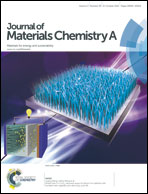Inorganic caesium lead iodide perovskite solar cells†
Abstract
The vast majority of perovskite solar cell research has focused on organic–inorganic lead trihalide perovskites. Herein, we present working inorganic CsPbI3 perovskite solar cells for the first time. CsPbI3 normally resides in a yellow non-perovskite phase at room temperature, but by careful processing control and development of a low-temperature phase transition route we have stabilised the material in the black perovskite phase at room temperature. As such, we have fabricated solar cell devices in a variety of architectures, with current–voltage curve measured efficiency up to 2.9% for a planar heterojunction architecture, and stabilised power conversion efficiency of 1.7%. The well-functioning planar junction devices demonstrate long-range electron and hole transport in this material. Importantly, this work identifies that the organic cation is not essential, but simply a convenience for forming lead triiodide perovskites with good photovoltaic properties. We additionally observe significant rate-dependent current–voltage hysteresis in CsPbI3 devices, despite the absence of the organic polar molecule previously thought to be a candidate for inducing hysteresis via ferroelectric polarisation. Due to its space group, CsPbI3 cannot be a ferroelectric material, and thus we can conclude that ferroelectricity is not required to explain current–voltage hysteresis in perovskite solar cells. Our report of working inorganic perovskite solar cells paves the way for further developments likely to lead to much more thermally stable perovskite solar cells and other optoelectronic devices.

- This article is part of the themed collection: 10th Anniversary: Most popular articles

 Please wait while we load your content...
Please wait while we load your content...